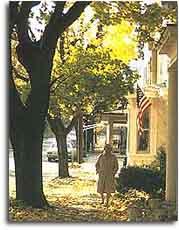 Urban Tree Canopy: What is it?
Urban Tree Canopy: What is it?
Urban tree canopy (UTC) is the layer of leaves, branches, and stems of trees that cover the ground when viewed from above.
What does it have to do with the Bay restoration strategy?
Trees provide stormwater management function by intercepting rainfall. The Stream ReLeaf (riparian forest buffer) strategy seeks to plant streamside forests in order to treat water before it reaches the Bay. However, in urban areas, stormwater by design goes from an impervious surface to a conveyance (like a curb and gutter) to an inlet to a pipe and into the Bay or one of its tributaries. So streamside forests in urban settings, where possible, would have little opportunity to treat stormwater as a main premise is to reduce flooding by getting the water from where it lands out into the Bay as quickly as possible. The Urban Tree Canopy goals seek to improve water quality by reducing water quantity in urban areas by increasing Urban Tree Canopy and reducing surface runoff.
What are the Urban Tree Canopy goals?
The goals were signed in 2003 by the Chesapeake Executive Council, whose members include the Governors of Maryland, Pennsylvania, Virginia, West Virginia, New York and Delaware; the Mayor of the District of Columbia; the Chesapeake Bay Commission chair; and the administrator of the EPA. Here is the 2003 Directive on Expanded Riparian Forest Buffer Goals in the Chesapeake Watershed.
Who is participating in the Urban Tree Canopy goals effort?
Thirty-six communities in Maryland have committed to participation in the Urban Tree Canopy Goal effort to date. They include Annapolis, Baltimore, Baltimore County (29 communities), Bowie Cumberland, Greenbelt, Hyattsville, and Rockville. These communities have a combined population of over 1.4 million (this is more than one quarter of Maryland's urban population) and they fall within five of the State's ten Tributary Strategies watersheds (Upper Potomac, Middle Potomac, Upper Western Shore, Lower Western Shore, and Patapsco/Back). Baltimore and Annapolis have already adopted goals; the other communities are in the process of assessing their existing and potential UTC. For a map of participating communities by Tributary Strategies watershed, click here.
Technical assistance partners include MD DNR, the Chesapeake Bay Program, the US Forest Service, and the University of Vermont Spatial Analysis Lab.
The Chesapeake Bay Trust’s Community Greening grant supports communities that have committed to Urban Tree Canopy goals and urban tree planting.
Additional Urban Tree Canopy resources:
Baltimore City Urban Tree Canopy Goal documents
- A Report on Baltimore City's Present and Potential Urban Tree Canopy
(http://gis.w3.uvm.edu/utc/Reports/TreeCanopy_Report_BACI_2007.pdf)
- Baltimore City Urban Tree Canopy Google Earth overlays (requires Google Earth 4.0) courtesy of US Forest Service, University of Vermont and the Baltimore Ecosystem Study (https://beslter.org/frame7-page_4.html)
Annapolis Urban Tree Canopy Goal documents
- A Report on Annapolis City's Present and Potential Urban Tree Canopy
( https://www.fs.fed.us/nrs/utc/reports/UTC_Report_Annapolis.pdf)
Frederick Urban Tree Canopy Goal documents
Hyattsville Urban Tree Canopy Goal documents
Cumberland Urban Tree Canopy Goal document
Washington, DC Urban Tree Canopy Goal documents